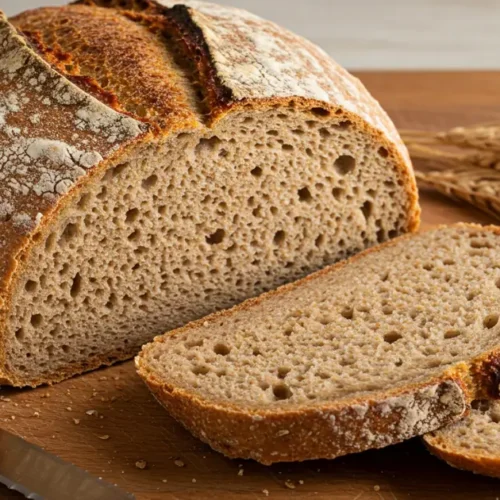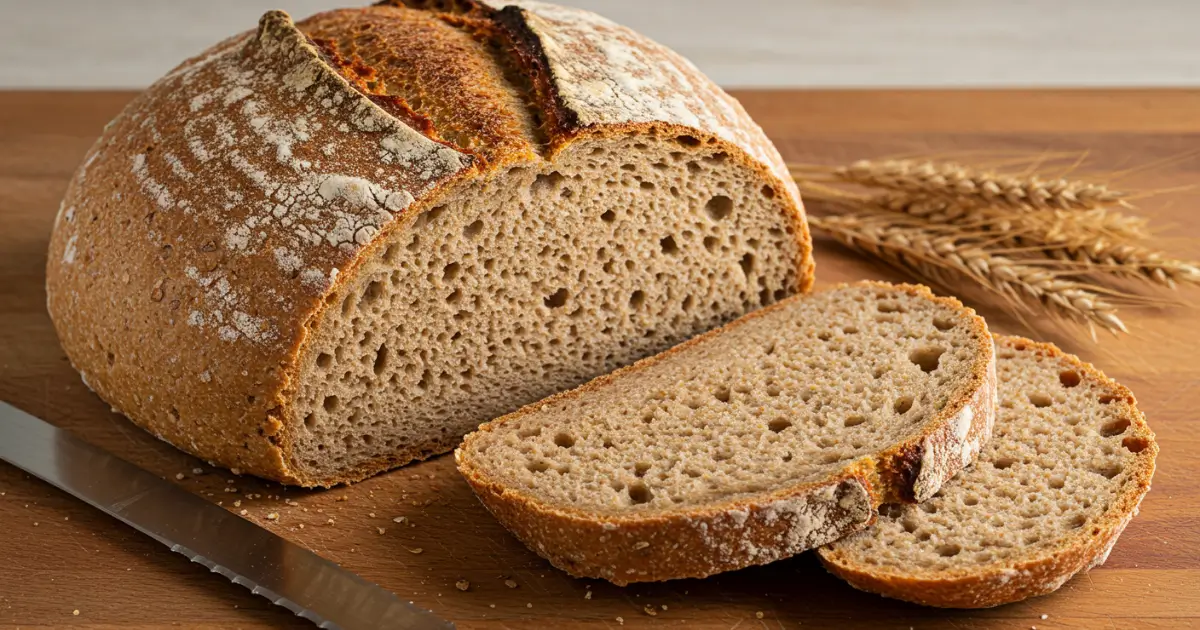When you think of bread, what comes to mind? Perhaps a soft, warm loaf fresh from the oven or a crispy slice to accompany a hearty soup. For many of us, bread is a comfort food that brings a sense of warmth and joy. But what if you could enjoy this staple without the guilt? Healthy bread is the answer. Imagine biting into a slice of homemade bread that’s not only satisfying but also packed with nutrients and free from unnecessary additives. It’s the perfect balance of taste and nutrition—and it’s easier to make than you think.
Why We Love Healthy Bread
Bread has always been a beloved comfort food, but when you choose healthy bread, you’re not just indulging in something delicious—you’re nourishing your body, too. Here are just a few reasons why healthy bread is a great choice for anyone who loves bread:
Packed with Nutrients
Healthy bread is made from whole grains, which means it’s loaded with essential nutrients that benefit your body. Whole wheat flour, for example, retains all parts of the grain—the bran, germ, and endosperm—unlike refined white flour, which has been stripped of its nutrients. Whole grains provide fiber, B vitamins, iron, magnesium, and antioxidants, all of which contribute to better overall health.
Supports Digestive Health
Thanks to its high fiber content, healthy bread can support better digestion. Fiber helps move food through your digestive system, promoting regular bowel movements and a healthy gut. Plus, fiber can help reduce the risk of chronic conditions like heart disease, diabetes, and certain cancers.

Low in Sugar
One of the main benefits of healthy bread is that it’s free from added sugars. Many commercial bread products are loaded with refined sugars to enhance flavor and extend shelf life. Healthy bread, on the other hand, relies on natural ingredients like honey or maple syrup for a subtle sweetness, making it a much better choice for anyone looking to reduce their sugar intake.
Helps Maintain Steady Blood Sugar Levels
Whole grain bread has a lower glycemic index compared to white bread, meaning it causes a slower, more stable increase in blood sugar levels. This makes it a better choice for anyone looking to maintain healthy blood sugar levels, especially those managing conditions like diabetes.
Ingredients for Healthy Bread
To make healthy bread, the right ingredients are key. Here’s a breakdown of what you’ll need for a basic recipe:
Whole wheat flour – Gives the bread a hearty texture and rich flavor.
Leavening – Yeast helps the bread rise, creating a soft and airy texture.
Olive oil – Keeps the bread moist and adds a slight richness.
Honey – Adds natural sweetness and moisture to the bread.
How to Make Healthy Bread
Making healthy bread at home might seem intimidating, but it’s actually quite simple! With a few basic ingredients and some patience, you can enjoy fresh, homemade bread that’s as healthy as it is delicious. Here’s a step-by-step guide to making your own loaf of healthy bread:
Activate the Yeast: In a small bowl, combine the warm water and honey. Stir to dissolve the honey, then sprinkle in the yeast. Let it sit for about 5 to 10 minutes, or until it becomes foamy. This means the yeast is activated and ready to use.
Mix the Dough: In a large mixing bowl, combine the whole wheat flour and salt. Add the activated yeast mixture and olive oil, stirring until a dough starts to form. You may need to add a little more flour if the dough is too sticky, or a bit more water if it’s too dry.
Knead the Dough: Turn the dough out onto a floured surface and knead for about 8-10 minutes. Kneading is essential for developing the gluten, which gives the bread its structure and texture. Once the dough is smooth and elastic, place it in a lightly greased bowl.
Let the Dough Rise: Cover the bowl with a clean towel or plastic wrap and let the dough rise in a warm place for 1 to 2 hours. It should double in size.
Shape and Bake: After the dough has risen, punch it down to release any air bubbles. Shape the dough into a loaf and place it into a greased loaf pan. Let it rise for another 30 minutes before baking at 375°F (190°C) for 25 to 30 minutes, or until the bread is golden brown and sounds hollow when tapped on the bottom.
Cool and Slice:
Once your bread is done, remove it from the oven and let it cool on a wire rack before slicing. This will help preserve the texture and prevent the bread from becoming too dense.
Expert Tips for Perfect Healthy Bread
To ensure that your healthy bread turns out perfectly every time, here are a few expert tips to keep in mind:
Don’t Skip the Kneading: Kneading is essential for building gluten, which gives the bread its chewy, airy texture. If you don’t knead long enough, your bread will be dense.
Use Fresh Yeast: Check the expiration date of your yeast before using it. Old yeast won’t activate properly, leading to a dense loaf.
Proper Water Temperature: The water used to activate the yeast should be warm, not hot. If it’s too hot, it can kill the yeast, and if it’s too cold, the yeast won’t activate properly. Aim for about 100°F (37°C).
Let the Dough Rise Properly: Give your dough enough time to rise. If you rush the process, the bread won’t rise fully and may have a heavy texture.
Add Seeds for Extra Nutrition: Consider adding flaxseeds, chia seeds, or sunflower seeds to your dough for added fiber, healthy fats, and omega-3 fatty acids.
Variations of Healthy Bread
Healthy bread is versatile, and you can customize it to suit your taste. Here are a few variations to try:
Oatmeal Bread: Replace part of the whole wheat flour with rolled oats for a heartier, fiber-packed loaf. This variation is perfect for a breakfast bread that pairs wonderfully with butter or jam.
Sourdough Bread: If you’re looking for a tangier, more complex flavor, try making sourdough bread. This type of bread uses a naturally fermented starter instead of yeast, giving it a unique taste and texture.
Gluten-Free Healthy Bread: If you’re following a gluten-free diet, you can use almond flour, coconut flour, or a gluten-free flour blend in place of wheat flour. These alternatives provide a soft, moist loaf without the gluten.
Herb-Infused Bread: Add fresh herbs like rosemary, thyme, or basil to your dough for a savory twist. This variation pairs perfectly with soups, salads, and roasted meats.
Serving Healthy Bread
Once your healthy bread is baked, there are countless ways to enjoy it. Here are some serving suggestions:
As a Sandwich Base: Use slices of healthy bread to make sandwiches with your favorite fillings, from lean proteins to fresh vegetables and spreads.
With Soups or Stews: Serve a warm, crusty slice of bread alongside a bowl of hearty soup or stew. The bread soaks up the flavors and adds a satisfying crunch.
For Toast: Healthy bread makes an excellent base for toast. Top with avocado, nut butter, or a poached egg for a nutritious breakfast or snack.
More Bread recipes you will love!
cinnamon raisin sourdough bread
FAQs About Healthy Bread
What makes healthy bread healthier than regular bread?
Healthy bread is made with whole grains, fewer sugars, and no artificial preservatives. It’s packed with fiber, vitamins, and minerals that are stripped away in white bread.
Is healthy bread good for weight loss?
Yes! Healthy bread is made with whole grains that keep you feeling full longer, helping to prevent overeating. Plus, it’s lower in sugar and higher in fiber than regular bread.
Can healthy bread be made without yeast?
Yes! You can make quick breads without yeast by using baking soda or baking powder as leavening agents. These breads don’t require a rise time and can be made in a fraction of the time.
Can I add sweeteners to healthy bread?
You can add natural sweeteners like honey or maple syrup to healthy bread for a subtle sweetness. These options provide nutrients and flavor without the added sugar of traditional bread.

Healthy Bread
Equipment
- Loaf Pan
Ingredients
- 2 cups Whole Wheat Flour
- 1 cup Warm Water lukewarm
- 1 tbsp Honey
- 1 tsp Yeast
- 1 tbsp Olive Oil
- 1 tsp Salt
Instructions
- Combine the warm water, honey, and yeast in a small bowl. Let sit for 5-10 minutes until foamy.
- In a large mixing bowl, combine the whole wheat flour and salt.
- Add the activated yeast mixture and olive oil. Stir until a dough forms.
- Knead the dough on a floured surface for 8-10 minutes until smooth and elastic.
- Place the dough in a greased bowl, cover, and let rise for 1-2 hours until doubled in size.
- Shape the dough into a loaf and place in a greased loaf pan. Let rise for another 30 minutes.
- Bake at 375°F (190°C) for 25-30 minutes or until golden brown and hollow when tapped.
- Cool on a wire rack before slicing to preserve the texture.
Send me this recipe!
Just enter your email below and get it sent straight to your inbox!


